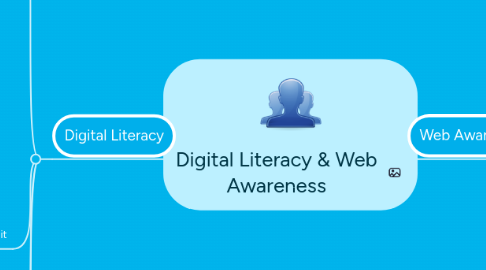
1. Digital Literacy
1.1. Developing ethical behaviour
1.1.1. Identity
1.1.1.1. online identity vs. offline identity
1.1.1.1.1. 3 facts/ 1 fiction
1.1.2. Privacy
1.1.2.1. Digital footprint
1.1.2.1.1. This can demonstrate how easy it is to trace the history of someone's online activity.
1.1.3. Ownership
1.1.3.1. Taking responsibility for your own actions
1.1.3.1.1. Ask
1.1.3.1.2. Acknowledge
1.1.3.1.3. Add value
1.1.3.1.4. Don't forget that digital learning can take place from a offline resources as well.
1.1.4. Trustworthiness
1.1.4.1. Explore the ethics of online communities
1.1.4.1.1. e.g. What harm could come from falsified information?
1.1.5. Particiaption
1.1.5.1. www.commonsense.org
1.2. What is it
1.2.1. The essential first step to becoming media literate in the 21st century.
1.2.1.1. tremendous opportunity to engage in a global community
1.2.1.1.1. Connection
1.2.1.1.2. Collaborative learning
1.2.1.1.3. learning community
1.2.1.1.4. Information access
1.2.1.2. Tremendous peril
1.2.1.2.1. Identity theft
1.2.1.2.2. Sexting
1.2.1.2.3. Cyberbullying
1.2.1.2.4. Plagiarism
1.2.1.2.5. Pedetrors
1.2.2. It's not just about using technology it's about thinking how students can use it as a tool and not as a weapon.
1.2.2.1. Students are not just consumers of information but that they are also creators of information.
1.2.2.1.1. Think before you click
1.2.3. Respect for others
1.2.4. Repeat for yourself
1.2.5. Respect Intellectual property
1.3. Helpful links
1.3.1. Technology briefing
1.3.2. how to prevent cyber bullying?
1.3.3. Nine key elements of Digital citizenship
1.4. Netiquette
1.4.1. Rules that should be applied online
1.4.1.1. Digital Netiquette
1.4.1.1.1. This is funny, but informative
2. Web Awareness
2.1. Internet safety
2.1.1. Some great resources for teachers and parents on media awareness
2.1.1.1. Media Smarts
2.1.1.2. Commonsense media
2.1.1.2.1. Scope and Sequence
2.1.1.3. Cybertalk
2.1.2. Impact of sexually explicit material
2.1.2.1. Impact on viewing sexually explicit material
2.1.2.1.1. For parents and teachers
2.1.2.2. Good pictures bad pictures
2.1.2.2.1. A good resource for parents to talk about pornography
2.1.3. Cyberbullying
2.1.3.1. The dangers of cyber bullying
2.1.4. Web Awareness for teachers
2.1.4.1. "in loco parentis"
2.1.4.1.1. The unofficial guardian of a child when a parent is not present.
2.1.4.2. Teaching web awareness to students
2.1.4.3. Educational games as platforms for internet safety
2.1.4.4. Cybertips for teachers
2.1.4.4.1. This is from the Canadian Teachers Federation
2.1.4.5. Get Cybersafe Canada
2.1.4.5.1. Government of Canada
2.2. Authenticity of Web Resources
2.2.1. Evaluating criteria
2.2.2. A great classroom activity for authenticating online websites
2.2.3. Consider email validity
2.2.4. Fact or folly
2.2.4.1. 1
2.2.4.2. 2
2.2.4.3. 3
2.2.5. Marketing to children
2.2.5.1. Stats about marketing to children
2.2.5.1.1. 1
2.2.5.1.2. 2
2.2.5.2. How do these companies market their product?
2.2.5.2.1. Barbie
2.2.5.2.2. Candystand
2.2.5.3. How marketers target kids
2.3. Privacy
2.3.1. Smartphones pictures pose privacy risks
2.3.2. A Student's guide to personal publishing
2.3.3. Very informative video on privacy
2.4. Copyright
2.4.1. Intellectual property
2.4.2. Copyright and the web
2.4.3. It is the jurisprudence of intellectual rights attributed an author or an artist
2.4.3.1. Encourage students to use Creative commons
2.4.3.1.1. Teachers should model the appropriate use of thesematierals and give credit to where it is due.

